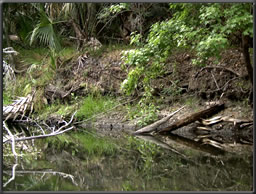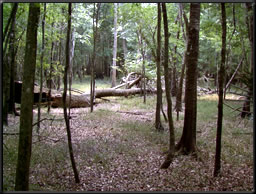Peninsular Florida Low Gradient, Blackwater
 This Regional Guidebook is designed to be used in riverine, low-gradient, blackwater stream,
forested wetlands in peninsular Florida. The riverine bottomland hardwood forest subclass
experiences a great amount of wetland permitting activity. This subclass is associated typically
with 1st-4th order streams, and has three potential water sources: 1) lateral surface or near-surface
transport from overbank flow; 2) infiltration of surface runoff from adjacent landforms facilitated
by the characteristically porous sandy soils; and 3) groundwater discharge to the wetland. Floodplains
with moderately entrenched streams of this wetland subclass experience flooding (i.e., discharge exceeds
channel-full capacity) usually on an annual basis (Clewell 1991). Floodplains with slightly entrenched or
anastomosed channels flood more frequently.
This Regional Guidebook is designed to be used in riverine, low-gradient, blackwater stream,
forested wetlands in peninsular Florida. The riverine bottomland hardwood forest subclass
experiences a great amount of wetland permitting activity. This subclass is associated typically
with 1st-4th order streams, and has three potential water sources: 1) lateral surface or near-surface
transport from overbank flow; 2) infiltration of surface runoff from adjacent landforms facilitated
by the characteristically porous sandy soils; and 3) groundwater discharge to the wetland. Floodplains
with moderately entrenched streams of this wetland subclass experience flooding (i.e., discharge exceeds
channel-full capacity) usually on an annual basis (Clewell 1991). Floodplains with slightly entrenched or
anastomosed channels flood more frequently.
 Flood frequency for both channel types in peninsular Florida is determined by an increase in local
rainfall events where overbank flow is locally described as "flashy". Beck (1965) recognizes sand-bottomed
streams as the most widely distributed type in Florida. These blackwater, sandy-bottomed rivers are low in
suspended sediment loads, usually clear but contain highly colored tannic acid and dissolved organic
matter (DOM) derived from detrital remains that drain from depressional wetlands (Wharton et al. 1982) and
other vegetative communities within the basin. The inorganic ions of iron and aluminum that complex with
DOM are in high concentrations and constitute a ratio of 1:1 in blackwater streams (Wharton et al.1982).
The dissolved organic humic and fluvic acids contribute to high total organic carbon concentrations and
a low pH (Wharton et al.1982). The forested reaches of this subclass create a habitat complexity that facilitates
a high diversity of both terrestrial and aquatic fauna (Estevez, Dixon, Flannery 1991). Other functions performed
by these bottomland hardwood forest stands include strong biogeochemical activity and nutrient cycling
(Gregory et al. 1991).
Flood frequency for both channel types in peninsular Florida is determined by an increase in local
rainfall events where overbank flow is locally described as "flashy". Beck (1965) recognizes sand-bottomed
streams as the most widely distributed type in Florida. These blackwater, sandy-bottomed rivers are low in
suspended sediment loads, usually clear but contain highly colored tannic acid and dissolved organic
matter (DOM) derived from detrital remains that drain from depressional wetlands (Wharton et al. 1982) and
other vegetative communities within the basin. The inorganic ions of iron and aluminum that complex with
DOM are in high concentrations and constitute a ratio of 1:1 in blackwater streams (Wharton et al.1982).
The dissolved organic humic and fluvic acids contribute to high total organic carbon concentrations and
a low pH (Wharton et al.1982). The forested reaches of this subclass create a habitat complexity that facilitates
a high diversity of both terrestrial and aquatic fauna (Estevez, Dixon, Flannery 1991). Other functions performed
by these bottomland hardwood forest stands include strong biogeochemical activity and nutrient cycling
(Gregory et al. 1991).
Guidebook
Uranowski, C., et al. (2003). "A Regional Guidebook for Applying the Hydrogeomorphic Approach to Assessing
Wetland Functions of Low-Gradient, Blackwater Riverine Wetlands in Peninsular Florida,"
ERDC/EL TR-03-3,
U.S. Army Engineer Research and Development Center, Vicksburg, MS.

Back to HGM Approach
Web Date: October 1997
Updated: April 2008
|

